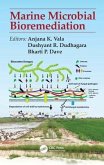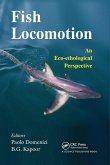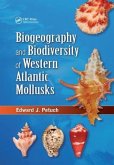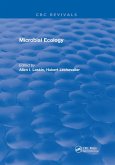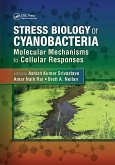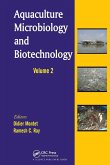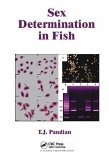Handbook of Methods in Aquatic Microbial Ecology
Herausgeber: Kemp, Paul F; Sherr, Barry F; Cole, Jonathan J
Handbook of Methods in Aquatic Microbial Ecology
Herausgeber: Kemp, Paul F; Sherr, Barry F; Cole, Jonathan J
- Broschiertes Buch
- Merkliste
- Auf die Merkliste
- Bewerten Bewerten
- Teilen
- Produkt teilen
- Produkterinnerung
- Produkterinnerung
Handbook of Methods in Aquatic Microbial Ecology is a comprehensive compilation of methods that a researcher, whether experienced or novice, might consider in applying to aquatic microbial ecology problems.
Andere Kunden interessierten sich auch für
![Marine Microbial Bioremediation Marine Microbial Bioremediation]() Marine Microbial Bioremediation100,99 €
Marine Microbial Bioremediation100,99 €![Fish Locomotion Fish Locomotion]() Fish Locomotion80,99 €
Fish Locomotion80,99 €![Biogeography and Biodiversity of Western Atlantic Mollusks Biogeography and Biodiversity of Western Atlantic Mollusks]() Edward J PetuchBiogeography and Biodiversity of Western Atlantic Mollusks106,99 €
Edward J PetuchBiogeography and Biodiversity of Western Atlantic Mollusks106,99 €![Microbial Ecology Microbial Ecology]() Allen I. LaskinMicrobial Ecology64,99 €
Allen I. LaskinMicrobial Ecology64,99 €![Stress Biology of Cyanobacteria Stress Biology of Cyanobacteria]() Stress Biology of Cyanobacteria101,99 €
Stress Biology of Cyanobacteria101,99 €![Aquaculture Microbiology and Biotechnology, Volume Two Aquaculture Microbiology and Biotechnology, Volume Two]() Aquaculture Microbiology and Biotechnology, Volume Two101,99 €
Aquaculture Microbiology and Biotechnology, Volume Two101,99 €![Sex Determination in Fish Sex Determination in Fish]() T J PandianSex Determination in Fish101,99 €
T J PandianSex Determination in Fish101,99 €-
-
-
Handbook of Methods in Aquatic Microbial Ecology is a comprehensive compilation of methods that a researcher, whether experienced or novice, might consider in applying to aquatic microbial ecology problems.
Produktdetails
- Produktdetails
- Verlag: Taylor & Francis Ltd (Sales)
- Seitenzahl: 800
- Erscheinungstermin: 13. Dezember 2019
- Englisch
- Abmessung: 271mm x 180mm x 2mm
- Gewicht: 1402g
- ISBN-13: 9780367449858
- ISBN-10: 0367449854
- Artikelnr.: 58440881
- Herstellerkennzeichnung
- Libri GmbH
- Europaallee 1
- 36244 Bad Hersfeld
- gpsr@libri.de
- Verlag: Taylor & Francis Ltd (Sales)
- Seitenzahl: 800
- Erscheinungstermin: 13. Dezember 2019
- Englisch
- Abmessung: 271mm x 180mm x 2mm
- Gewicht: 1402g
- ISBN-13: 9780367449858
- ISBN-10: 0367449854
- Artikelnr.: 58440881
- Herstellerkennzeichnung
- Libri GmbH
- Europaallee 1
- 36244 Bad Hersfeld
- gpsr@libri.de
Kemp, Paul F.; Cole, Jonathan J.; Sherr, Barry F.; Sherr, Evelyn B.
Introduction Section I: Isolation of Living Cells 1. Isolation and
Enumeration of Anaerobic and Microaerophiiic Bacteria in Aquatic Habitats
2. Isolation and Cultivation of Hyperthermophilic Bacteria from Marine and
Freshwater Habitats 3. Isolation of Psychrophilic Bacteria 4. Isolation and
Characterization of Bacteriocytes from a Bivalve-Sulfur Bacterium Symbiosis
5. General Techniques for the Isolation and Culture of Marine Protists from
Estuarine, Littoral, Psammolittoral, and Sublittoral Waters 6. Long-Term
Culture of Marine Benthic Protists 7. Behavior and Bioenergetics of
Anaerobic and Microaerobic Protists 8. Culturing Free-Living Marine
Phagotrophic Dinoflagellates 9. Enrichment, Isolation, and Culture of
Free-Living Heterotrophic Flagellates 10. Determination of Pressure Effects
on Flagellates Isolated from Surface Waters 11. Isolation, Cloning, and
Axenic Cultivation of Marine Cilliates 12. Isolation and Laboratory Culture
of Marine Oligotrichous Ciliates 13. Extraction of Protists in Aquatic
Sediments via Density Gradient Centrifugation Section II. Identification,
Enumeration, and Diversity 14. Statistical Analysis of Direct Counts of
Microbial Abundance 15. Enumeration and Isolation of Viruses 16. Total
Count of Viruses in Aquatic Environments 17. Improved Sample Preparation
for Enumeration of Aggregated Aquatic Substrate Bacteria 18. Direct
Estimates of Bacterial Numbers in Seawater Samples Without Incurring Cell
Loss Due to Sample Storage 19. Total and Specific Bacterial Counts by
Simultaneous Staining with DAPI and Fluorochrome-Labeled Antibodies 20. Use
of RFLPs for the Comparison of Marine Cyanobacteria 21. Use of
High-Resolution Flow Cytometry to Determine the Activity and Distribution
of Aquatic Bacteria 22. Phytoplankton Analysis Using Flow Cytometry 23.
Enumeration of Phototrophic Picoplankton by Autofluorescence Microscopy 24.
Estimating Cell Concentration and Biomass of Autotrophic Plankton Using
Microscopy 25. Preservation and Storage of Samp
Enumeration of Anaerobic and Microaerophiiic Bacteria in Aquatic Habitats
2. Isolation and Cultivation of Hyperthermophilic Bacteria from Marine and
Freshwater Habitats 3. Isolation of Psychrophilic Bacteria 4. Isolation and
Characterization of Bacteriocytes from a Bivalve-Sulfur Bacterium Symbiosis
5. General Techniques for the Isolation and Culture of Marine Protists from
Estuarine, Littoral, Psammolittoral, and Sublittoral Waters 6. Long-Term
Culture of Marine Benthic Protists 7. Behavior and Bioenergetics of
Anaerobic and Microaerobic Protists 8. Culturing Free-Living Marine
Phagotrophic Dinoflagellates 9. Enrichment, Isolation, and Culture of
Free-Living Heterotrophic Flagellates 10. Determination of Pressure Effects
on Flagellates Isolated from Surface Waters 11. Isolation, Cloning, and
Axenic Cultivation of Marine Cilliates 12. Isolation and Laboratory Culture
of Marine Oligotrichous Ciliates 13. Extraction of Protists in Aquatic
Sediments via Density Gradient Centrifugation Section II. Identification,
Enumeration, and Diversity 14. Statistical Analysis of Direct Counts of
Microbial Abundance 15. Enumeration and Isolation of Viruses 16. Total
Count of Viruses in Aquatic Environments 17. Improved Sample Preparation
for Enumeration of Aggregated Aquatic Substrate Bacteria 18. Direct
Estimates of Bacterial Numbers in Seawater Samples Without Incurring Cell
Loss Due to Sample Storage 19. Total and Specific Bacterial Counts by
Simultaneous Staining with DAPI and Fluorochrome-Labeled Antibodies 20. Use
of RFLPs for the Comparison of Marine Cyanobacteria 21. Use of
High-Resolution Flow Cytometry to Determine the Activity and Distribution
of Aquatic Bacteria 22. Phytoplankton Analysis Using Flow Cytometry 23.
Enumeration of Phototrophic Picoplankton by Autofluorescence Microscopy 24.
Estimating Cell Concentration and Biomass of Autotrophic Plankton Using
Microscopy 25. Preservation and Storage of Samp
Introduction Section I: Isolation of Living Cells 1. Isolation and
Enumeration of Anaerobic and Microaerophiiic Bacteria in Aquatic Habitats
2. Isolation and Cultivation of Hyperthermophilic Bacteria from Marine and
Freshwater Habitats 3. Isolation of Psychrophilic Bacteria 4. Isolation and
Characterization of Bacteriocytes from a Bivalve-Sulfur Bacterium Symbiosis
5. General Techniques for the Isolation and Culture of Marine Protists from
Estuarine, Littoral, Psammolittoral, and Sublittoral Waters 6. Long-Term
Culture of Marine Benthic Protists 7. Behavior and Bioenergetics of
Anaerobic and Microaerobic Protists 8. Culturing Free-Living Marine
Phagotrophic Dinoflagellates 9. Enrichment, Isolation, and Culture of
Free-Living Heterotrophic Flagellates 10. Determination of Pressure Effects
on Flagellates Isolated from Surface Waters 11. Isolation, Cloning, and
Axenic Cultivation of Marine Cilliates 12. Isolation and Laboratory Culture
of Marine Oligotrichous Ciliates 13. Extraction of Protists in Aquatic
Sediments via Density Gradient Centrifugation Section II. Identification,
Enumeration, and Diversity 14. Statistical Analysis of Direct Counts of
Microbial Abundance 15. Enumeration and Isolation of Viruses 16. Total
Count of Viruses in Aquatic Environments 17. Improved Sample Preparation
for Enumeration of Aggregated Aquatic Substrate Bacteria 18. Direct
Estimates of Bacterial Numbers in Seawater Samples Without Incurring Cell
Loss Due to Sample Storage 19. Total and Specific Bacterial Counts by
Simultaneous Staining with DAPI and Fluorochrome-Labeled Antibodies 20. Use
of RFLPs for the Comparison of Marine Cyanobacteria 21. Use of
High-Resolution Flow Cytometry to Determine the Activity and Distribution
of Aquatic Bacteria 22. Phytoplankton Analysis Using Flow Cytometry 23.
Enumeration of Phototrophic Picoplankton by Autofluorescence Microscopy 24.
Estimating Cell Concentration and Biomass of Autotrophic Plankton Using
Microscopy 25. Preservation and Storage of Samp
Enumeration of Anaerobic and Microaerophiiic Bacteria in Aquatic Habitats
2. Isolation and Cultivation of Hyperthermophilic Bacteria from Marine and
Freshwater Habitats 3. Isolation of Psychrophilic Bacteria 4. Isolation and
Characterization of Bacteriocytes from a Bivalve-Sulfur Bacterium Symbiosis
5. General Techniques for the Isolation and Culture of Marine Protists from
Estuarine, Littoral, Psammolittoral, and Sublittoral Waters 6. Long-Term
Culture of Marine Benthic Protists 7. Behavior and Bioenergetics of
Anaerobic and Microaerobic Protists 8. Culturing Free-Living Marine
Phagotrophic Dinoflagellates 9. Enrichment, Isolation, and Culture of
Free-Living Heterotrophic Flagellates 10. Determination of Pressure Effects
on Flagellates Isolated from Surface Waters 11. Isolation, Cloning, and
Axenic Cultivation of Marine Cilliates 12. Isolation and Laboratory Culture
of Marine Oligotrichous Ciliates 13. Extraction of Protists in Aquatic
Sediments via Density Gradient Centrifugation Section II. Identification,
Enumeration, and Diversity 14. Statistical Analysis of Direct Counts of
Microbial Abundance 15. Enumeration and Isolation of Viruses 16. Total
Count of Viruses in Aquatic Environments 17. Improved Sample Preparation
for Enumeration of Aggregated Aquatic Substrate Bacteria 18. Direct
Estimates of Bacterial Numbers in Seawater Samples Without Incurring Cell
Loss Due to Sample Storage 19. Total and Specific Bacterial Counts by
Simultaneous Staining with DAPI and Fluorochrome-Labeled Antibodies 20. Use
of RFLPs for the Comparison of Marine Cyanobacteria 21. Use of
High-Resolution Flow Cytometry to Determine the Activity and Distribution
of Aquatic Bacteria 22. Phytoplankton Analysis Using Flow Cytometry 23.
Enumeration of Phototrophic Picoplankton by Autofluorescence Microscopy 24.
Estimating Cell Concentration and Biomass of Autotrophic Plankton Using
Microscopy 25. Preservation and Storage of Samp



